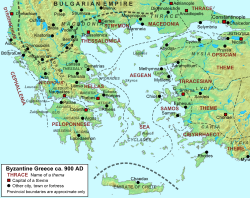Siege of Patras (805 or 807)
| Siege of Patras | |||||||
|---|---|---|---|---|---|---|---|
| |||||||
| Belligerents | |||||||
|
Byzantine inhabitants of Patras |
Slavs of the Peloponnese Saracen fleet (uncertain) | ||||||
The siege of Patras in 805 or 807 was undertaken by the local
Background
The

In Greece, the eastern coasts of the Peloponnese and
Patras, on the northwestern coast of the Peloponnese, is claimed by the Chronicle of Monemvasia—a work of highly disputed accuracy and chronology, but an essential source for the period[5][6]—to have been one of the cities abandoned c. 587/8 as a result of the Slavic depredations, its population fleeing to Rhegion in Calabria. This was followed by 218 years of independent Slavic occupation in the Peloponnese, until around 804/5.[7][8] The archaeological record on the other hand shows Patras to have remained in Byzantine control throughout the period, although it is possible that part of the population indeed immigrated to Italy.[9][10]
Siege of Patras
According to Chapter 49 of the
Constantine VII gives no precise date for the attack, but it has been usually dated to around 805, when the city of Patras was "re-founded", according to the Chronicle of Monemvasia, or to 807, when an Arab ("Saracen") fleet is known to have reached southern Greece,[13][14] although the Arab participation may well be the result of a later interpolation, mixing the real Slavic revolt with subsequent Arab raids.[15] The Chronicle of Monemvasia on the other hand does not mention any siege of the city. Instead, it records that an Armenian strategos at Corinth named Skleros defeated the Peloponnesian Slavs, and that this victory, in the year 804/5 or 805/6, marked the end of "218 years" of Slavic occupation in the Peloponnese. Emperor Nikephoros I is then said to have rebuilt Patras by bringing back the descendants of its original inhabitants from Rhegion, and to have engaged in a large-scale resettlement and Christianization program for the peninsula, bringing in Greek colonists from Italy and Asia Minor. Nikephoros' resettlement program at least is also confirmed by the chronicler Theophanes the Confessor, who puts it slightly later, in 810/1.[5][16][17]
Some scholars have tried to reconcile the conflicting accounts of the Chronicle and the De administrando imperio as implying a first recovery of Patras c. 805 as the result of Skleros' campaign, which was probably concurrent with the establishment of the Peloponnese as a separate theme from Hellas, if this had not been done slightly earlier. According to this interpretation, the Slavic revolt and attack on Patras followed as a reaction a few years later, between 807 and 811.[18]
Aftermath
Whatever the exact course of events in the early 9th century, the failure of the Slavic attack on Patras consolidated the recently re-established Byzantine control over the Peloponnese, and Nikephoros I's policies led to the successful re-Christianization and
According to Constantine VII, the Slavs rose up again in the early 840s, but were defeated by strategos Theoktistos Bryennios. In the south, the two tribes of the Ezeritai and Melingoi held out longer. They were eventually subdued and forced to pay heavy tribute, but retained their autonomy. These two tribes rose up again a century later, in 921. Again they were quickly subdued, this time by the strategos Krenites Arotras, but managed to remain autonomous and retain their distinct identity until well into Frankish times.[22][23][24]
The successful repulsion of the siege through the "intervention" of Saint Andrew also marked the abrupt rise of the see of Patras to prominence: formerly a
References
- ^ Curta (2006), pp. 70–75
- ^ Whittow (1996), pp. 266–270
- ^ Curta (2006), pp. 106–110
- ^ Fine (1991), pp. 60–64, 79
- ^ a b Curta (2006), pp. 114–115
- ^ Charanis (1950), pp. 141–166
- ^ Avramea (2012), pp. 141–142, 220
- ^ Charanis (1946), pp. 80–81
- ^ Avramea (2012), pp. 157–158, 220
- ^ a b Gregory (1991), pp. 1597–1598
- ^ Moravscik & Jenkins (1967), pp. 229, 231
- ^ Curta (2006), p. 111
- ^ Charanis (1946), pp. 83–84
- ^ Toynbee (1973), p. 99
- ^ Curta (2006), p. 111 note 1
- ^ Charanis (1946), pp. 81–83
- ^ Toynbee (1973), pp. 95–97
- ^ Fine (1991), pp. 80–81
- ^ Fine (1991), pp. 81–82
- ^ Avramea (2012), pp. 220–221
- ^ Curta (2006), p. 112
- ^ Moravscik & Jenkins (1967), pp. 233, 235
- ^ Curta (2006), pp. 115–116, 202–203
- ^ Toynbee (1973), pp. 100–101
Sources
- Avramea, Anna (2012). Η Πελοπόννησος από τον 4ο ως τον 8ο αιώνα: Αλλαγές και συνέχεια [The Peloponnese from the 4th to the 8th century: Changes and continuity.] (in Greek). Athens: National Bank of Greece Cultural Foundation. ISBN 978-960-250-501-4.
- Charanis, Peter (1946). "Nicephorus I, The Savior of Greece from the Slavs (810 A.D.)". Byzantina-Metabyzantina. I, Part I. New York: 75–92.
- Charanis, Peter (1950). "The Chronicle of Monemvasia and the Question of the Slavonic Settlements in Greece". Dumbarton Oaks Papers. V. Washington, DC: 141–166. JSTOR 1291076.
- ISBN 978-0-521-81539-0.
- ISBN 0-472-08149-7.
- Gregory, Timothy E. (1991). "Patras". In ISBN 0-19-504652-8.
- Moravscik, Gyula; Jenkins, R.J.H., eds. (1967). Constantine Porphyrogenitus: De Administrando Imperio. Washington, DC: Dumbarton Oaks. ISBN 0-88402-021-5.
- ISBN 0-19-215253-X.
- ISBN 978-0-520-20496-6.
